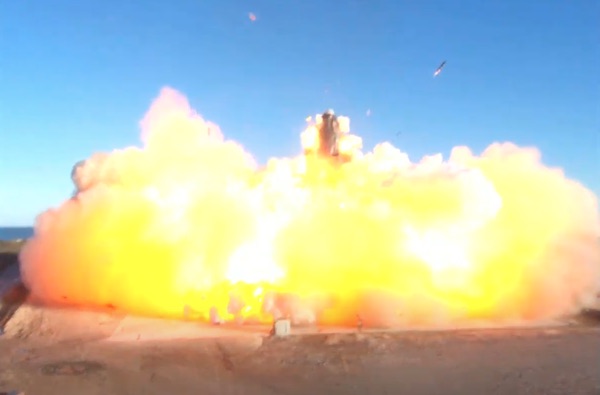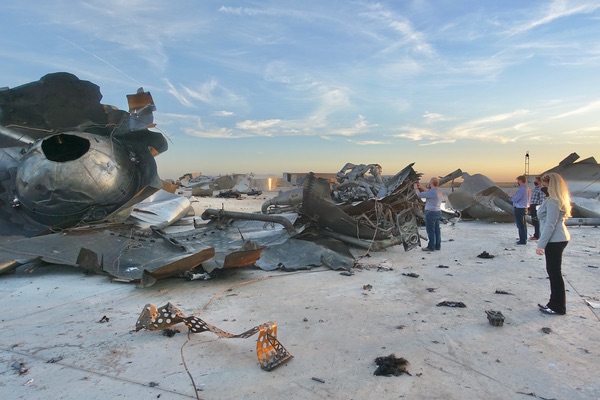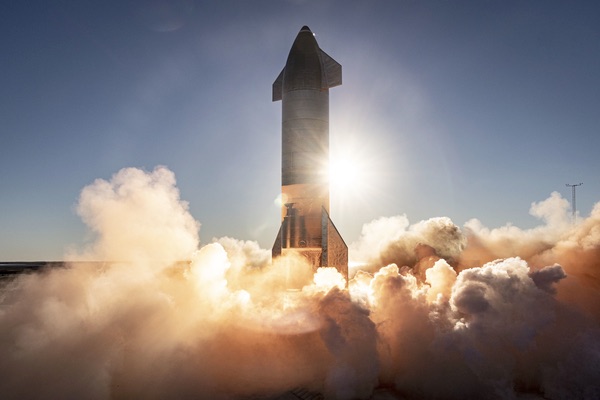Starship contradictionsby Jeff Foust
|
| Moments after the explosion, the company’s webcast of the flight continued to show the debris, and lingering flames and smoke, on the landing pad, along with a message: “Awesome Test. Congrats Starship Team!” |
Those are some of the contrasts that come to mind about last week’s test flight of a prototype of SpaceX’s Starship next-generation launch vehicle designated SN8. Two earlier prototypes, SN5 and SN6, each made brief “hop” flights in August and September, respectively, going to about 150 meters altitude and remaining airborne for only about a minute each. SN8, though, would fly as high as 12.5 kilometers, then fall back to the launch site at Boca Chica, Texas, reigniting its Raptor engines again for a powered landing.
On the afternoon of December 9, that long-awaited flight finally happened. SN8 ignited its three Raptor engines and lifted off the pad. Over the next four and a half minutes one engine, and then a second, shut down, before that third and final engine turned off. Starship then executed what’s become known as a “belly flop” maneuver, shifting to a horizontal orientation for its descent. The flaps on the vehicle’s nose section, and at its base, guided the vehicle towards a landing pad next to the launch site as it fell. To some, it looked like an airship, albeit one that lost its buoyancy.
Six and a half minutes after liftoff, Starship SN8 reignited at least two of those Raptor engines and reoriented to the vertical again to make a powered landing. But something went wrong with the engines, which lost thrust; their exhaust turned green, perhaps from copper from the engines’ chambers. Instead of lightly touching down on the pad, SN8 smashed into it, causing an explosion that wrecked the vehicle.
That spectacular explosion led much of the coverage of the flight, particularly in more mainstream media outlets. From a purely visual standpoint, it’s easy to see why: the explosion looked like something out of a Michael Bay movie. Many accounts hyped up the explosion, suggesting the flight was a failure because of that explosive ending.
SpaceX took a different view. Moments after the explosion, the company’s webcast of the flight continued to show the debris, and lingering flames and smoke, on the landing pad, along with a message: “Awesome Test. Congrats Starship Team!”
SpaceX founder and CEO Elon Musk was equally pleased. “Successful ascent, switchover to header tanks & precise flap control to landing point!” he tweeted minutes after that explosion. The crash—or, he called it, the RUD, or “rapid unscheduled disassembly”—was because of low pressure in a fuel tank that kept the engines from slowing the vehicle down enough. But, he added, “we got all the data we needed! Congrats SpaceX team hell yeah!!”
Or, as he put it a little later that day, “SN8 did great! Even reaching apogee would’ve been great, so controlling all way to putting the crater in the right spot was epic!!”
Double-exclamation-point exuberance aside, Musk and SpaceX have a point. The company has taken an iterative approach to testing new technologies, running the risk of crashes and explosions along the way. That’s something not often seen elsewhere in the space industry where a more cautious, and less destructive, approach to testing has been the norm.
That was apparent in the company’s work on reusability, which first involved being able to land a Falcon 9 booster after launch. Many of those attempts ended in dramatic failures, with boosters crashing into the decks of droneships or toppling over upon landing. Yet the company learned from the experience, and today such landings are routine—it’s the launch where the first stage isn’t recovered, or fails to land, that is noteworthy. SpaceX even released a blooper reel of those failed landings.
 SpaceX’s Starship SN8 explodes upon landing on its December 9 test flight. (credit: SpaceX) |
From that perspective, it’s easy to see why SpaceX would consider this flight to be (mostly) a success. The company, at the very least, gathered plenty of data about the performance of the vehicle through most phases of flight, either confirming their expectations or allowing them to revise their models. And SN8 is hardly the first Starship prototype to meet a destructive demise: four others have been destroyed in earlier tests, such as tanks that burst in pressurization tests and a vehicle that exploded after a static-fire test in May. Last week was just another time where stainless steel shrapnel has been strewn across the sandy terrain at Boca Chica.
| “SN8 did great! Even reaching apogee would’ve been great, so controlling all way to putting the crater in the right spot was epic!!” Musk tweeted. |
Those failures have taken place in view of public. A cottage industry of livestreams has emerged in the last year to monitor the goings-on at Boca Chica, from local residents who found themselves with an unlikely front-row seat for space industry history to media and spaceflight enthusiasts who have set up increasingly elaborate livestreams and photo documentation of the work there. They keep track of the day-to-day work on the steady stream of Starship prototypes there as well as various tests.
Many people use that documentation as proof that SpaceX is open about its Starship work. A state highway runs by both the launch site, next to Boca Chica Beach, and the production facility a short distance west. Except on days when the highway is closed for testing, anyone can drive by, stop, and take photos—and many do, it seems. It’s a striking contrast to those companies that do development and testing in more remote or otherwise inaccessible areas.
That openness, though, is not the same as transparency. Those eagle-eyed observers can spot many things going on at Boca Chica, including some things SpaceX probably is not eager to publicize, like the partial collapse of a stand supporting the next Starship prototype, SN9, two days after the flight of SN8. Photographers were able to see the vehicle leaning against one side of its high bay, and then later moved upright again by a crane, but the company hasn’t said how much damage it sustained and how it might affect test flight plans.
SpaceX has kept many details about Starship testing close to the vest. While many reports stated that the vehicle flew to an altitude of 12.5 kilometers on last week’s flight, that was simply the planned altitude for the test. SpaceX hasn’t disclosed exactly high it flew. It also didn’t release a flight profile, as it does with Falcon 9 launches, thus we can’t compare the flight we saw with what the company planned. For example, did the Raptor engines shut down during the vehicle’s ascent according to plan, or for other reasons? The company’s webcast appears to show a brief fire in the engine bay after the first engine shut down, which, at the very least, seems undesirable.
SpaceX did have that webcast, with both ground-based views of Starship as well as from cameras on the vehicle. It was, though, a remarkably barebones affair for a company that raised the bar for launch webcasts across the industry. A typical Falcon 9 launch webcast, for example, will have one or more company engineers as hosts, with elaborate graphics showing the speed and altitude of the rocket and the phase of flight. The Starship webcast, though, had no commentary beyond a feed from launch control, and only a countdown clock on the screen.
At least SpaceX is doing better than other commercial space companies when it comes to openness. There’s been a recent trend of companies carrying out major events, including orbital launches, out of public view. When Virgin Orbit performed its first LauncherOne launch in May, the company only provided a regular series of tweets about the progress of the mission, and the ultimate failure to reach orbit. The company said the first-time nature of the launch, and its use of an air-launch system that was off the coast of southern California at the time of launch, kept it from broadcasting the launch.
Another small launch vehicle company, Astra Space, also didn’t offer a live webcast of its Rocket 3.1 launch in September from Kodiak Island, Alaska. That launch failed to reach orbit when a guidance problem triggered a flight termination system, shutting down the engines and causing the vehicle to crash near the launch site shortly after liftoff. (A few local residents, though, were able to capture video of the brief flight, posting it to social media.)
Astra is back at Kodiak for a second launch attempt, Rocket 3.2, now scheduled for no earlier than Tuesday. The company said last week would not provide a livestream of the launch. “It’s critical during this time of COVID-19 that we keep a lean and socially-distanced team on the ground at Kodiak, therefore, we will not be able to offer a public live stream,” it stated in a blog post. (Emphasis, presumably, on “public,” since it’s reasonable to think employees will be able to monitor the launch by video.)
| At least SpaceX is doing better than other commercial space companies when it comes to openness. There’s been a recent trend of companies carrying out major events, including orbital launches, out of public view. |
Private companies, of course, can choose to be as open or as closed as they’d like if they’re using private funding and private facilities. But being able to know more than just what a company is willing to tweet is important, particularly during launches. On Saturday, Virgin Galactic’s WhiteKnightTwo took off from Spaceport America in New Mexico, carrying SpaceShipTwo for what the company expected to be the first suborbital spaceflight of the vehicle since last February, and the first from that spaceport. The company, though, said it would provide no live video of the flight, and restricted access to the spaceport to only essential personnel because of the pandemic.
Fortunately, Jack Beyer of NASASpaceFlight.com was able to provide live video from outside the spaceport grounds, allowing the public to see SpaceShipTwo separate from WhiteKnightTwo, ignite its hybrid engine—and then immediately shut down that engine. SpaceShipTwo glided back to a safe landing, as seen on the livestream. The company took nearly ten minutes after SpaceShipTwo’s release and abort to provide an update via Twitter about the flight, and longer to offer a report with any details about the abort (which it said was due to a computer that lost connection at the time of engine ignition, triggering the shutdown.)
 Steve Jurvetson, a member of SpaceX’s board, took this picture December 10 of of the debris left behind by SN8’s fiery demise. (credit: Steve Jurvetson CC BY 2.0) |
SpaceX, by comparison, offers some insight into its activities. In the past Musk has provided more details in a series of updates, most recently in September of last year Boca Chica. Musk has been promising a similar update for months, but it’s unclear if it will be a webcast or perhaps, as he suggested at one point, a written summary of some kind.
If he does provide that update, he will no doubt mention the rapid pace of progress the company has made since last September, building and testing—and sometimes destroying—Starship prototypes. And he’ll likely made bold promises about the future.
While some will accept those schedules for future achievements as gospel, it’s worth remembering that his schedules are sometimes, well… aspirational. Take, for example, that update last September: “This thing is going to take off, fly to 65,000 feet, about 20 kilometers, and come back and land, in about one or two months,” he said, referring to the Starship Mark 1 vehicle behind him (see “Starships are meant to fly”, The Space Review, September 30, 2019).
Mark 1, of course, did not fly to 20 kilometers in one to two months: it was the first of several prototypes destroyed in testing. It took SpaceX 14 months to achieve that first high-altitude flight (and SN8 didn’t go all the way to 20 kilometers, but 12.5 kilometers is close enough here.)
“And this is going to sound totally nuts, but I think we want to try to reach orbit in less than six months,” he added at last year’s event, an estimate he said was “accurate to within a few months.” Correct, perhaps, for large values of few. Musk more recently suggested an orbital flight might take place in 2021.
Despite falling short of those schedules, Musk continues to make bold forecasts, such as when he was asked at a December 1 event in Berlin, where he accepted an award from publisher Axel Springer, when he thought SpaceX would send humans to Mars. “I think if you say six years from now, I’m highly confident. If we get lucky maybe four years,” he said. An uncrewed mission could launch in the next window, in two years, he added.
| “I think if you say six years from now, I’m highly confident. If we get lucky maybe four years,” Musk said of sending humans to Mars. |
Keep in mind, though, that Starship is just part of the overall launch system that includes a much larger booster called Super Heavy, development of which is still in its early stages. Its size, including a large (if varying) number of Raptor engines, will doubtless make development challenging. SpaceX thought the Falcon Heavy could launch as early as 2013; it finally made its first flight in early 2018, and that leveraged the extensive work on the Falcon 9. SpaceX also has to work with the FAA on updating the environmental assessment of the Boca Chica site to support Starship/Super Heavy launches, a process that will take months in the best case, and years in the worst. Getting just an uncrewed mission to Mars launched in six years may be ambitious.
SpaceX advocates will argue that this time will be different, that progress is accelerating, and that Musk’s schedules should be taken seriously. That could all be true, but experience suggests a degree of skepticism is warranted. In the meantime, it looks like there will be plenty more prototypes that will fly—and possibly explode—from South Texas in the months to come. Just don’t forget to webcast them.
Note: we are temporarily moderating all comments submitted to deal with a surge in spam.
